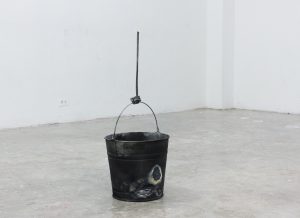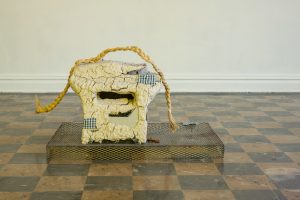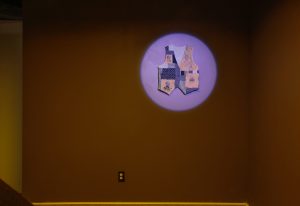By Adriana Vélez
Coco Klockner is a multimedia artist who constantly reinvents familiar concepts, such as film and gender, through sculpture and art installations. Despite being located an ocean apart, I was able to interview them through Zoom and we discussed outdated gender ideas, their creative process, the polarizing themes in The PowerPuff Girls, NFts, and more.
AV: Let’s start with some background information. How did you get introduced to the art world and when did you start creating?
CK: I started drawing at a pretty young age. My mom was an editor for a children’s book publisher, and she worked from home, so there was a lot of art coming through our house growing up. I originally went to school just wanting to be an illustrator. Once I got in, it was like a rabbit hole that sucks you into various random spaces and you start asking questions. I ended up going through many roles—curator in artist-run spaces, conceptual and post-conceptual practices. Ultimately, I’m doing what I know—which is that sometimes I’m queer. Two years ago, I was pouring a lot of energy into writing a novella that I feel is still super relevant to my studio practice. Now, I’m pouring more into object-based sculpture.
What have been some of your biggest inspirations in your career, in terms of other artists and their work?
I think early on I was really into playful painting styles. Chris Johanson was a painter I was really inspired by. As I went to a more theory-oriented world, I was really interested in Hito Steyerl and her approach to talking about aesthetics and politics. Harun Farocki is a big influence for her. Another thing I’m interested in is what aesthetics can mean as a creative practice. As far as themes and images, there are materials that I try to allow myself to obsessively pursue, like mid-90s and 2000s tech aesthetics. For example, printers made of plastics that age poorly, turn yellowish tan, and have button-oriented interfaces, which feels super out of date at this point. I can’t really imagine technical approaches that do anything other than a touchscreen anymore. I feel like it’s those simple approaches that I lock unto and end up having larger significance. I’m also inspired by thinking of images as objects, sounds as objects and the way those things get processed by an audience in an art setting or outside of an art setting.

Galvanized steel bucket, rope, resin
Y2K aesthetics have had a really big revival in the last year or so and it’s been really interesting seeing it slowly creep into every facet of the art world. We’re seeing it very prominently in fashion, but seeing it in a fine arts setting is going to be quite interesting. A decade’s aesthetic will have a revival every couple of years but I think it’s unusual that we’re seeing such a large resurgence of a decade that ended quite recently. So, I looked over your archive and your collections on your website. I loved your collections from 2020 and 2019 and had a couple of questions about them. With your 2020 collection, I saw that the overall theme is gender binaries and gender dysphoria. How does your relationship with gender and your view on gender binaries impact and correlate with your art?
I think I came out to friends that I wanted to use nonbinary [pronouns] at the end of 2016. Five years later, it feels much easier to say but at the time, it was sort of significant to say “I don’t feel binary trans, this is not working, whatever this is.” I think there’s a lot of interesting fallout from that. Critical discourse now can still feel very binary for reasons that make sense as far as what has the highest stakes—healthcare, safe spaces, etc. I just always feel that “binary”, to me, is a precarious, futile goal. When I approach aspects of medical transition and personal presentation, they always just bring a constant tension, which I think harps back to things that are out of vogue in some ways. Talking specifically about structuralist and post-structuralist theory of what language does, and how it constructs from the ground up very specific histories of language…the way that I’m interested in using sound, images, and sculptures is in trying to think about subject and object, which have a weird interplay where one becomes another and vice versa. A lot of these fifty-year theory questions end up being non-academic but super personal as far as asking how does anyone get categorized, what is subject and object, and what does anyone want to be.

5-gallon bucket, wood, acrylic latex, wire
With your 2019 collection I noticed the theme was films, specifically Silence of the Lambs. There was also the inclusion of the character Him, from The Powerpuff Girls show. Going back to my question of your inspirations, how do other mediums like film and music influence your work?
I go back and forth on how to approach other mediums quite a bit. Pop cinema of the 80’s and 90’s have a lot of influence in what became hegemonic today. I regularly ask, “What should I be working on as a primary medium? Maybe this makes sense, to be the change I want to see.” But I think there is a really nice element of having a degree of removal from screen culture or any other mediums. You get to remove yourself from within that equation. I want to point to other things, real objects that we can interact with but get seen as separate from the world when it’s actually the primary way that we’re interacting. I feel like I’ve probably spent more screen time watching a depicted world than going outside, which doesn’t seem that radical of a statement. I think that using art, sculpture, and installations helps me be more creative in what I think is interesting, like mass market Hollywood movies that never asked to be critically reviewed. I think that bringing in any children’s show always feels very specific in gesturing towards the more insidious aspects of indoctrination. I love Him’s character from The Powerpuff Girls. At the same time I have to ask, how does this keep happening? How do trans femme characters always go hand in hand with villainy?

12’17” 4-channel audio, acrylic, aluminum, carpet, steel, chicken bones, wash rags, 5-gallon bucket, plasticine, charcoal
I think by implementing film in an exhibition space, it becomes a very unifying experience for all the viewers because it’s something that so many of them can instantly recognize. They can interpret the piece in their own way by associating it with the film and their experience with it. It’s such an interesting time in the art world because now more than ever, artists are not limited to a single medium and they can pick and choose which elements to integrate into their practice. By integrating film in an installation space, it completely reconstructs the idea of a film and gives you the creative freedom to dictate its meaning, like your piece Silence of the Lambs.
Another aspect of that piece that doesn’t totally translate over the documentation is that it was a totally immersive installation where people could enter the space between the four speakers. This dynamic happened, which I hadn’t totally planned out, where the rest of the room was dark except for that yellow space. When people went in to have the sound experience, it was like they were going on stage and became performers themselves. Everyone felt really comfortable just staring at them through the yellow screen and there was a weird separation between them. I’m really interested in what doesn’t translate over digitally circulated images, which at this point is the only thing we see anymore.
I think how we translate exhibition spaces and physical art pieces into the digital space is something that has been rediscovered because of quarantine. We can’t experience these artworks and exhibition spaces anymore and they were never meant to be digital. I think the next five years are going to be a time of discovery of what the art world can be and how we can experience it again. Moving on to my next question, could you tell me what your creative process is like and how you go from an intangible idea to something physical?
I try to not to get too locked into a single process, which keeps things exciting but also makes the process more crisis-oriented. Everything always feels like it’s on the verge of failure, but I think writing has a consistent role in everything I do. It may start with an essay that spawns an idea that doesn’t quite resolve itself, which leads to a sketch, and then there are five variations of what that sketch might look like because of technical problems. Especially when working with physical scale or volume I have to ask: “What can I afford and what can I find?”. There are also limitations with what I feel comfortable buying new. There are certain highly wasteful practices that I don’t want to perpetuate. If there is a way that I can be working with upcycling of waste, I feel much better about a piece taking up space. It’s kind of a series of keys through a canal. What’s possible? What feels right? What makes sense? Then something trickles down through the bottom and it might be the most distilled aspect of the original thing.

Aerosol paint on nylon, installed at Vent Space, Baltimore, MD, USA
That’s so interesting. I didn’t know your work had an eco-conscious aspect to it and to me, it makes it even more exciting. We have to be conscious of our impact on the world and what lasting impact art will eventually create in terms of the environment. My next question is actually about your writing process since I read some of your essays. How does your writing process differ from creating art and sculptures?
I think I try not to separate them too much. For a while, I was really into the idea of exhibition as an essay. I’ve realized that when I’m recalling information from a book, the memory ends up being really spatial. Like, I’ll remember the space on a page where a quote was written on. Because page formats are always rectangular, I think “well that looks like a room”. Physical spaces end up being very language based. For example, when you’re describing a room you say “there’s a bucket there, there’s a well there, etc”. I was working on that when I was in grad school, experimental exhibitions and what kind of level I could push from an audience. I leaned into that hard and now I’m leaning out. I think that’s one aspect of what the process is like. Other times, I think good writing often can’t be as indulgent. My favorite objects are the ones that you can’t describe because they don’t resolve into any sort of conclusion, which is the best part about them. I wrote an essay that I haven’t uploaded to the website but was published last month in a magazine called Real Life. It’s about a meme that started doing rounds on Tik Tok last year called Main Character Energy and I feel like it ended up being the embodiment of the same thoughts that I’ve been talking about: film, cinema, the things I found value in living which end up dictating moral codes. When I’m going over things I’ve written with an editor, I end up coming to certain conclusions I’m not sure I would reach if I was just working with material [art] because if someone is going to be reading 2500 words, I have to make it worth their while. Whereas if someone is walking into a room, they can walk in and spin right out of there.

Brother laser printer, greenware, steel, chicken bones, plasticine, wash rags, charcoal, basket reed
I’m very interested in your response to this next question because it’s such a hot topic right now. What’s your opinion on NFTs?
I have thoughts on NFTs. Maybe some background would be the novella I referenced earlier. It’s a speculative fiction about blockchain succession from the United States creating its own currency and an extended metaphor of sex as economy. It ended up being this queer series of metaphors and double entendres. I think it’s really sad when something like an NFT, which on its own has some amazing aspects, gets obscured by the hype around it. It becomes very gendered and capital heavy, the most horrible things get made synonymous with what it is. But I think there are some very amazing aspects of it, like the idea of artists getting resale royalties for any piece that might recirculate after the initial sale. One thing that the art economy has allowed to fuck over generation after generation of artists who sell a painting for a couple hundred dollars is that, then it ends up selling for a hundred thousand dollars not that long after and the artist is still in the same situation. Dealers and galleries have said for years that this [resale royalties] is not a feasible thing to do and this new technology [NFTs] allows it to happen without the need for a broker and everything happens automatically. As far as what is happening currently in terms of the bubble that seems to keep growing, that is bad for everyone. At some point the bubble will burst, and whoever the people are that think GIFs made by a stranger will keep their value won’t be able to sell it a second time. I hope everyone makes it out of the pump and dump okay. I think beyond the hype there are some really valuable aspects of NFTs. Also, it’s allowing people that work digitally to be working in their native medium without having to come up with trinkets to sell to support themselves.
I think NFTs have some really great aspects but also some bad ones. I think it’ll come down to personal decision from the buyers and the artist whether to get involved or not. It’s important to consider the ecological aspect and the fact that the bubble will eventually burst. It’s still a really great opportunity for artists to gain recognition and compensation for their work in a platform that otherwise would go unnoticed.
The ecological question is totally valid. I personally have decided that I won’t engage and mint things until proof of stay comes around. For the people that think that one is evil for engaging in NFTs and cryptocurrency, I think they’re not aware of the real background of Etherium, which has a lot of development around it and ecological questions are going to be resolved sooner than we think. I also think it’s interesting how something like that gets so much energy in an artist conversation. Bitcoin has no plans of lowering their ecological impact and it uses three times more energy than Ethereum. Total art sales also make up only like 5 or 10% of etherium usage.

Cotton, beet dye, cabbage dye, light
My last question: are you currently working on anything in what can we expect from you during 2021?
I have been using the pandemic time to work on music a lot, which I’m trying to figure out how to do in the way that I was talking about, in terms of a one degree removed-perspective. At the moment that is what I’ve been working on. There’s the release of an EP that I recently collaborated on in a couple of weeks, and hopefully a full length [album] at the end of the year. Also, undoing the thing I just said and working directly on film. There’s a short film that I collaborated on that will premier at USC at the end of April. Then, a show in San Francisco with a friend in September. That’s a lot of things I’ve been working on in the past year that are finally coming out.
Is music a new medium for you?
It’s actually a return for me. I played a lot with friends when I was still in undergrad. I feel like the art world has had such a depressing, disappointing response to the pandemic that I think music has done a much better job at being a satisfying cultural moment to be experiencing remotely. Anytime I’ve been listening to music really loud during the pandemic I’ve been like “That is an actual satisfying experience.” So, I’m returning to it.
To view more of Klockner’s work: http://cocoklockner.info/
To listen Klockner’s musical collaboration: https://orbtapes.bandcamp.com/album/i-might-have-to-use-this-on-my-landlord